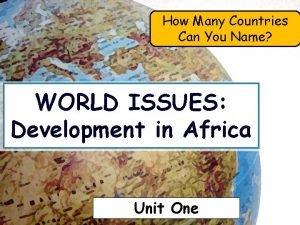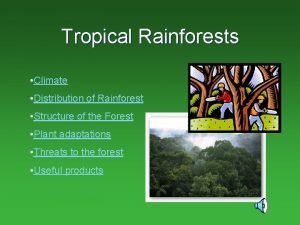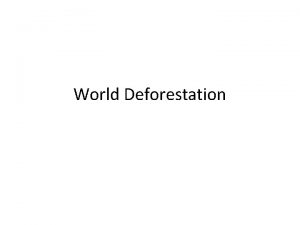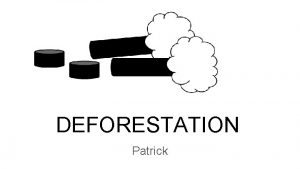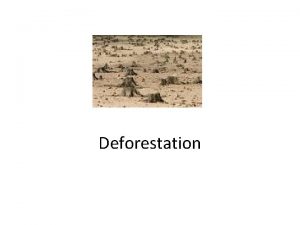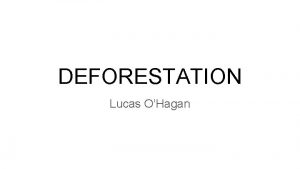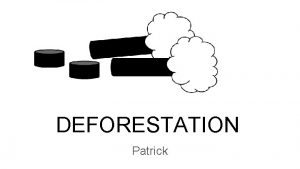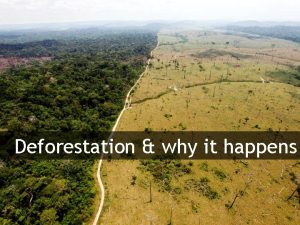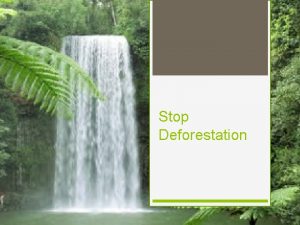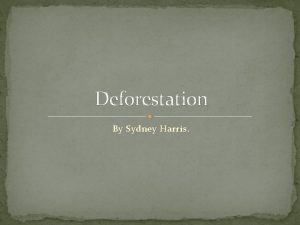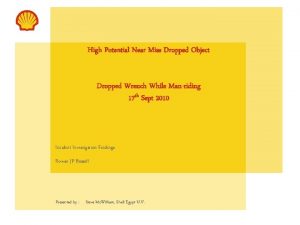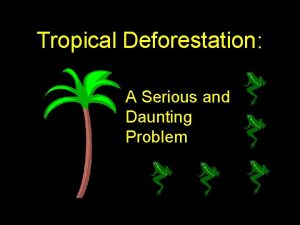World Deforestation Deforestation rates in tropical countries dropped













- Slides: 13

World Deforestation

• Deforestation rates in tropical countries dropped significantly during the first decade of the 21 st century relative to the 1990 s, reveals new data released by the Food and Agriculture Organization of the United Nations (FAO).

• FAO figures show deforestation across 121 tropical countries averaged 9. 34 million hectares per year between 2000 and 2010, down from 11. 33 million hectares per year in the 1990 s. Mongabay. com

• The decline has accelerated since 2005 due Brazil's dramatic reduction of deforestation in the Brazilian Amazon, which peaked at 27, 772 square kilometers in 2004 but is expected to come in at less than 8, 000 for 2010. Overall Brazil's reduction in deforestation since 2005— which fell from 3. 2 million hectares per year from 20002005 to 2. 5 million hectares in 2005 -2010—more than offset increases in forest clearing in other major forest countries including Indonesia (107 percent increase), Peru (94 percent), and Madagascar (36 percent) during the period. • Read more: http: //news. mongabay. com/2010/1006 fao_forest_cover. html#ixzz 1 v 9 qktu 9 A

• FAO estimates global deforestation fell from 16 million hectares per year in the 1990 s to 13 million hectares per year in the past decade. Factoring in planted forests, the loss of forest cover fell from 8. 3 million hectares per year to 5. 2 million hectares, an area about the size of Costa Rica. Read more: http: //news. mongabay. com/2010/1006 fao_forest_cover. html#ixzz 1 v 9 r 1 Kl. AJ

Deforestation in Brazil • In many tropical countries, the majority of deforestation results from the actions of poor subsistence cultivators. However, in Brazil only about one-third of recent deforestation can be linked to "shifted" cultivators. Historically a large portion of deforestation in Brazil can be attributed to land clearing for pastureland by commercial and speculative interests, misguided government policies, inappropriate World Bank projects, and commercial exploitation of forest resources. For effective action it is imperative that these issues be addressed. Focusing solely on the promotion of sustainable use by local people would neglect the most important forces behind deforestation in Brazil. Mongabay. com

The Scene • The Amazon rainforest is one of the most biodiverse regions on earth. It is home to nearly 10% of the world’s mammals 1 and a staggering 15% of the world’s known landbased plant species, with as many as 300 species of tree in a single hectare. Greenpeace

The Scene • The region is also home to about 220, 000 people from 180 different indigenous nations 3 who live deep in the rainforest, along with many more traditional forest-dependent communities. The rainforest provides these people with everything from food and shelter to tools and medicines, and plays a crucial role in the spiritual life of indigenous peoples. Greenpeace

The Scene • All this is threatened by deforestation and related crimes, committed for the sake of the profits to be made from agricultural commodities such as soya. Greenpeace

The Crime • Between August 2003 and August 2004, 27, 200 km – an area the size of Belgium – was lost. Three-quarters of this destruction was illegal. 5 That’s an area 10 km long by 7. 5 km wide lost every day. More than 3 km 2 every hour. A football pitch every eight seconds. Greenpeace

The Criminals • Three US-based agricultural commodities giants – Archer Daniels Midland (ADM), Bunge and Cargill – are responsible for about 60% of the total financing of soya production in Brazil. Together, these three companies also control more than three-quarters of the soya crushing capacity in Europe that supplies soya meal and oil to the animal feed market. Greenpeace

The Criminals • 80% of the world’s soya production is fed to the livestock industry. • Spiralling demand for soya animal feed from European agribusiness is driving the expansion of the agricultural frontier into the Amazon rainforest. Europe buys half the soya exported from the Amazon state of Mato Grosso, where 90% of rainforest soya is grown. Greenpeace

Danger to those who oppose deforestation • Chico Mendes and Brazil http: //www. dailymotion. com/video/xeywsj_imp act-of-the-murder-of-chico-mende_tech Based on the Greenpeace presentation on commercial farming for animal feed, did the death of Chico Mendes make a difference? A. Yes B. No
 Unit ratio
Unit ratio Equivalent ratios
Equivalent ratios Ratios rates and unit rates
Ratios rates and unit rates Ratios rates and unit rates
Ratios rates and unit rates Cost of world war 1
Cost of world war 1 Impact of neo colonialism on third world countries
Impact of neo colonialism on third world countries First wolrd countries
First wolrd countries Site:slidetodoc.com
Site:slidetodoc.com Well done children
Well done children How many countries in the world
How many countries in the world World war 2 countries
World war 2 countries Distribution of rainforests
Distribution of rainforests Static dropped object
Static dropped object Se + verb spanish
Se + verb spanish









